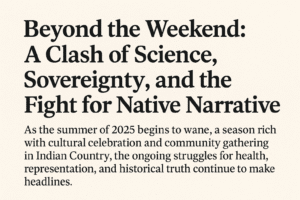Beyond the Weekend: A Clash of Science, Sovereignty, and the Fight for Native Narrative
Amid a summer of cultural celebration, critical news emerged for Native communities. A major rift developed as pediatricians broke with federal policy to recommend COVID-19 vaccines for children, a decision complicated by historical medical trauma and political skepticism. Simultaneously, California Assemblymember James C. Ramos delivered a powerful rebuke to a colleague for exploiting tribal history for political gain, connecting past genocide to present-day disrespect. These stories underscore the complex challenges of navigating health and representation. They highlight the vital need for the sustained, Indigenous-led journalism that documents these battles, not as isolated events, but as part of the broader, essential fight for food sovereignty, language revitalization, and cultural survival against a backdrop of historical loss and ongoing resilience.

Beyond the Weekend: A Clash of Science, Sovereignty, and the Fight for Native Narrative
As the summer of 2025 begins to wane, a season rich with cultural celebration and community gathering in Indian Country, the ongoing struggles for health, representation, and historical truth continue to make headlines. For those catching up after a busy weekend, two stories from California and the national stage reveal the complex and critical issues facing Native communities today.
1. A Pediatric Schism: Trust, Trauma, and the Shadow of History in Vaccine Policy
As children across the nation head back to school, a surprising and profound rift has emerged between the American Academy of Pediatrics (AAP) and the federal government over COVID-19 vaccines for young children.
In a move that breaks a 30-year consensus, the AAP is now recommending vaccinations for young children, directly contradicting a policy shift initiated in May by CDC head Robert F. Kennedy, Jr., who removed the universal recommendation for children six months and older. Kennedy’s public retort, questioning the AAP’s motives by pointing to its donors—including vaccine manufacturers—adds a layer of political intrigue to a public health issue.
For Native families, this conflict is not merely academic. It lands on the fertile ground of a well-justified historical trauma. The legacy of unethical medical experimentation and broken government promises has fostered a deep-seated skepticism toward federal health initiatives within many Indigenous communities. This schism between a trusted professional body like the AAP and a controversial political appointee forces parents into a difficult position: navigating the crossfire of a political debate while weighing the very real health risks COVID-19 poses to their elders and vulnerable community members.
The core of the story, therefore, transcends the simple question of “to vaccinate or not.” It becomes a story about trust, the weaponization of science, and the extra burden placed on communities that have historically been harmed by the very institutions now offering guidance.
2. In California’s Capitol, a Raw Rebuke of Historical Exploitation
Meanwhile, in the California State Assembly, a different kind of battle over legacy and power was unfolding. Native American Assemblymember James C. Ramos delivered a powerful and emotionally charged condemnation of a colleague who, during a redistricting debate, invoked the historical treatment of tribes to argue against a modern proposal.
Ramos’s anger was not about the redistricting itself, but about the exploitation of Native suffering for political convenience. His speech cut to the heart of a painful dynamic often faced by Indigenous peoples: their history of genocide and displacement being used as a rhetorical tool by others, only when it serves a contemporary agenda.
“When you start to exploit the history in the state of California for your own gain,” Ramos stated, “it [is] the same tactics used when this land was stolen and murdered people of our culture to get it.”
His remarks went beyond the immediate political scuffle, highlighting a ongoing, tangible injustice: the presence of Native ancestors’ remains stored as “trophies” in state archives. This powerful connection between a political comment and the physical, unresolved evidence of genocide served as a stark reminder that history is not a abstract concept for debate, but a living, painful reality that continues to demand accountability and respect.
Ramos’s message was clear: true concern for Native history requires consistent action and respect, not selective outrage deployed for political gain. It was a warrior’s defense of his people’s memory, asserting that their past will not be used as a pawn in a political game.
The Larger Fight: Why These Stories Are Told
These two stories, one of public health and one of political power, are emblematic of the complex landscape Native communities navigate. They are also exactly the types of stories that dedicated, Indigenous-led journalism exists to cover.
As the footer of the newsletter highlights, outlets like Native News Online are engaged in a critical, multi-year project, “Cultivating Culture,” to document the parallel fights for food sovereignty and language revitalization. These efforts are not niche interests; they are fundamental to community health, resilience, and the preservation of identity in the wake of unimaginable loss, accelerated by events like the COVID-19 pandemic.
The work of telling these stories—whether about a vaccine policy, a fiery speech in a legislature, or an elder teaching a forgotten language—requires sustained, respectful, and well-funded journalism. It’s a reminder that behind every headline from Indian Country is a deeper context of cultural survival, a context that deserves to be understood in all its complexity. Supporting this kind of journalism isn’t just about funding news; it’s about investing in the preservation of history, culture, and truth itself.
You must be logged in to post a comment.